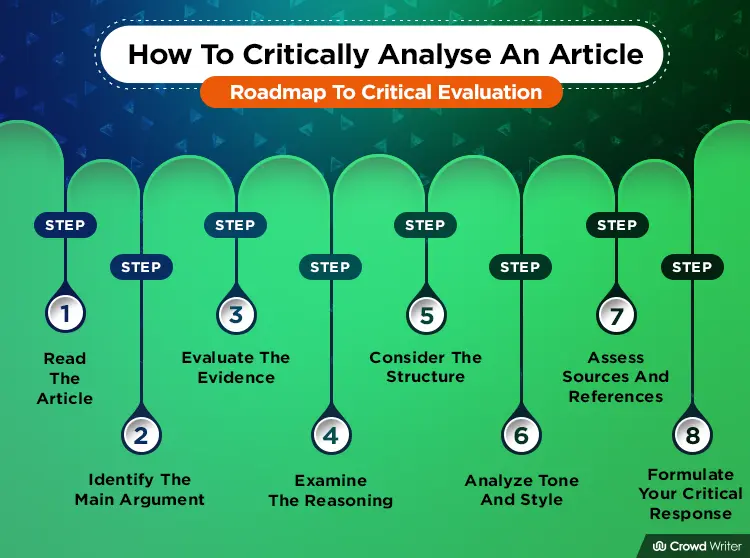
In the current academic scenario, knowing how to analyse an article critically is essential to attain stability and strength. It’s about reading between the lines, questioning what you encounter, and forming informed opinions based on evidence and sound reasoning.
Have you ever wondered how to tell if an article is good or not? It’s important when it comes to your academic superiority. Critical analysis of an article is like being a detective. You check the article closely to see if it makes sense, if the facts are correct, and if the writer is trying to trick you.
But it’s not just something for school, college or university; it’s a superpower for everyday life. It helps you find the important stuff in an article, spot when someone is trying to persuade you and understand what the writer really thinks.
Think of it as a special skill that lets you dig deep into an article, like a treasure hunt. You uncover hidden biases, find the truth, and see how the writer tries to convince you. It’s a bit like being a detective and a wizard at the same time.
Get ready to become a smart reader. This guide will show you how to use this superpower to make sense of the information around us in just 8 simple steps.

Before embarking on the journey to analyse an article critically, it is paramount to begin with the foundational step of reading the article itself. This step lays the groundwork for a comprehensive understanding of the material, enabling you to effectively evaluate its merits and demerits.
Reading an article critically starts with setting aside distractions and immersing yourself in the text. Instead of skimming through it hurriedly, take the time to read it meticulously.
To truly grasp the article’s essence, you must consider both its content and context. Content refers to the information and ideas presented within the article, while context encompasses the circumstances in which it was written.
As you read, do not rely solely on your memory to retain key points and insights. Taking notes is an invaluable practice during this phase. Record significant ideas, quotes, and statistics that catch your attention.
Your initial impressions of the article can offer valuable insights into your subjective response. If a particular passage elicits a strong emotional reaction, make a note of it. Identifying your emotional responses can help you later in the analysis process when considering your own biases and reactions to the author’s arguments.
While you are up to critically analyse an article, pinpointing the central argument is akin to finding the North Star guiding you through the article’s content. Every well-crafted article should possess a clear and concise main argument or thesis, which serves as the nucleus of the author’s message. Typically situated in the article’s introduction or abstract, this argument not only encapsulates the author’s viewpoint but also functions as a roadmap for the reader, outlining what to expect in the subsequent sections.
Identifying the main argument necessitates a discerning eye. Delve into the introductory paragraphs, abstract, or the initial sections of the article to locate this pivotal statement. This argument may be explicit, explicitly stated by the author, or implicit, inferred through careful examination of the content. Once you’ve grasped the main argument, keep it at the forefront of your mind as you proceed with your analysis, it will serve as the cornerstone against which all other elements are evaluated.
In order to solely understand how to analyse an article critically, it is imperative to know that an article’s persuasive power hinges on the quality of evidence presented to substantiate its main argument. In this critical step, it’s imperative to scrutinise the evidence with a discerning eye. Look beyond the surface to assess the data, statistics, examples, and citations provided by the author. You can run it through Turnitin for a plagiarism check. These elements serve as the pillars upon which the argument stands or crumbles.
Begin by evaluating the credibility and relevance of the sources used to support the argument. Are they authoritative and trustworthy? Are they current and pertinent to the subject matter? Assess the quality of evidence by considering the reliability of the data, the objectivity of the sources, and the breadth of examples. Moreover, consider the quantity of evidence; is there enough to convincingly underpin the thesis, or does it appear lacking or selective? A well-supported argument should be built upon a solid foundation of robust evidence.
Critical analysis doesn’t stop at identifying the argument and assessing the evidence; it extends to examining the underlying reasoning that connects these elements. In this step, delve deeper into the author’s logic and the structure of the argument. The goal is to identify any logical fallacies or weak assumptions that might undermine the article’s credibility.
Scrutinise the coherence and consistency of the author’s reasoning. Are there any gaps in the argument, or does it flow logically from point to point? Identify any potential biases, emotional appeals, or rhetorical strategies employed by the author. Assess whether the argument is grounded in sound principles and reasoning.
Be on the lookout for flawed deductive or inductive reasoning, and question whether the evidence truly supports the conclusions drawn. Critical thinking is pivotal here, as it allows you to gauge the strength of the article’s argumentation and identify areas where it may be lacking or vulnerable to critique.
The structure of an article is not merely a cosmetic feature but a fundamental aspect that can profoundly influence its overall effectiveness in conveying its message. A well-organised article possesses the power to captivate readers, enhance comprehension, and amplify its impact. To harness this power effectively, it’s crucial to pay close attention to various structural elements.
In essence, the structure of an article serves as the blueprint that shapes the reader’s journey. A thoughtfully organised article not only makes it easier for readers to navigate the content but also enhances their overall comprehension and retention. By paying attention to these structural elements, you can gain a deeper understanding of the author’s message and how it is effectively conveyed to the audience.
Exploring the tone and style of an article is like deciphering the author’s hidden intentions and underlying biases. It involves looking closely at how the author has crafted their words, examining their choice of language, tone, and use of rhetorical devices. Is the tone even-handed and impartial, or can you detect signs of favouritism or prejudice? Understanding the author’s perspective in this way allows you to place their argument within a broader context, helping you see beyond the surface of the text.
When you analyse tone, consider whether the author’s language carries any emotional weight. Are they using words that evoke strong feelings, or do they maintain an objective and rational tone throughout? Furthermore, observe how the author addresses counterarguments. Are they respectful and considerate, or do they employ ad hominem attacks? Evaluating tone and style can offer valuable insights into the author’s intentions and their ability to construct a persuasive argument.
A critical analysis wouldn’t be complete without examining the sources and references cited within the article. These citations form the foundation upon which the author’s arguments rest. To assess the credibility of the author’s research, it’s essential to scrutinise the origins of these sources. Are they drawn from reputable, well-established journals, books, or widely recognised and trusted websites? High-quality sources reflect positively on the author’s research and strengthen the overall validity of the argument.
While staying on the journey of how to critically analyse an article, be vigilant when encountering articles that heavily rely on sources that might be considered unreliable or biased. Investigate whether the author has balanced their sources and considered diverse perspectives. A well-researched article should draw upon a variety of reputable sources to provide a well-rounded view of the topic. By assessing the sources and references, you can gauge the robustness of the author’s supporting evidence.
Having navigated through the previous steps, it’s now your turn to construct a critical response to the article. This step involves summarising your analysis by identifying the strengths and weaknesses within the article. Do you find yourself in agreement with the main argument, or do you have reservations? Highlight the evidence that you found compelling and areas where you believe the article falls short. Your critical response serves as a valuable contribution to the ongoing discourse surrounding the topic, adding your unique perspective to the conversation. Remember that constructive criticism can lead to deeper understanding and improved future discourse.
Now, let’s be specific on two of the most analysed articles, i.e. research articles and journal articles.
A research article is a scholarly document that presents the findings of original research conducted by the author(s) and is typically published in academic journals. It follows a structured format, including sections such as an abstract, introduction, methods, results, discussion, and references. To critically analyse a research article, you may go through the following six steps.
Never hesitate to ask our customer support for examples and relevant guides as you face any challenges while critically analysing a research paper.
A journal article is a scholarly publication that presents research findings, analyses, or discussions within a specific academic or scientific field. These articles typically follow a structured format and are subject to peer review before publication. In order to critically analyse a journal article, take the following steps.
If you have any difficulty conducting a good critical analysis, you can always ask our research paper service for help and relevant examples.
Mastering the art of analysing an article critically is a valuable skill that empowers you to navigate the vast sea of information with confidence. By following these eight steps, you can dissect articles effectively, separating reliable information from biased or poorly supported claims. Remember, critical analysis is not about tearing an article apart but understanding it deeply and thoughtfully. With practice, you’ll become a more discerning and informed reader, researcher, or student.
Author Bio:
Laura Brown, a senior content writer who writes actionable blogs at Crowd Writer.